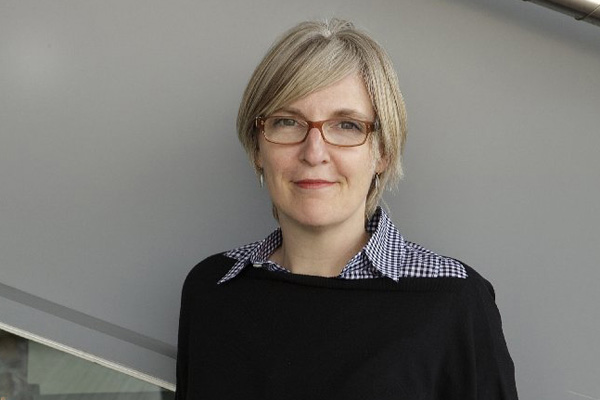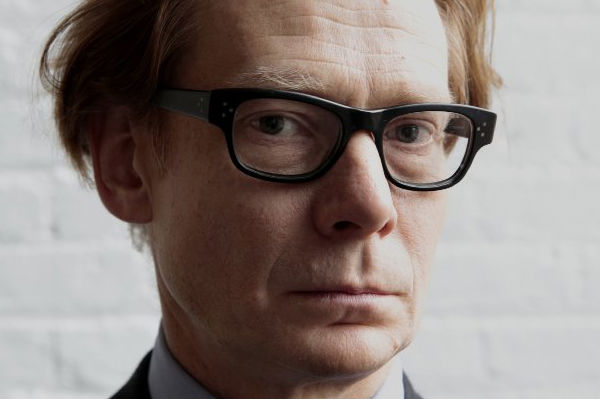MOCA in flux
A chronology of the Museum of Contemporary Art since 2000.
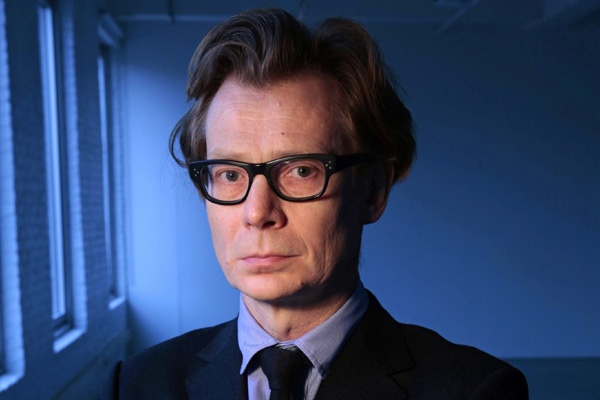
The Times reports that various signs indicate Philippe Vergne may be on his way out. The story is the first to report that Vergne has placed his $4-million Hollywood Hills mansion on the market. To questions about whether the museum will renew Vergne’s contract or whether it has begun the search for a new chief curator, the museum answers with a familiar response: “No comment.”
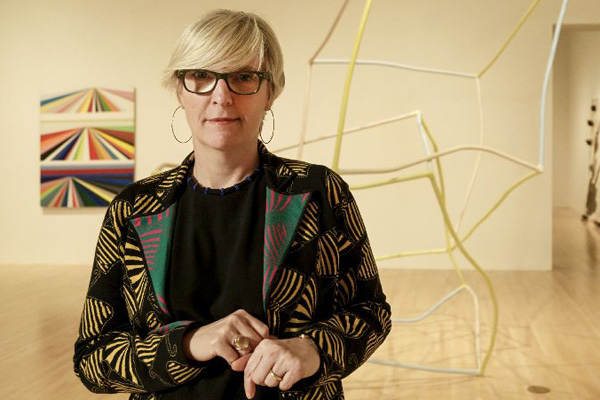
UCLA announces that Helen Molesworth will deliver the keynote commencement address at the university’s School of the Arts and Architecture. “To be an artist in an uncertain future, you must be brave, you must be bold, and you must strive for excellence,” Dean Brett Steele says, adding that in her career, Molesworth has “exemplified these values time and again.”
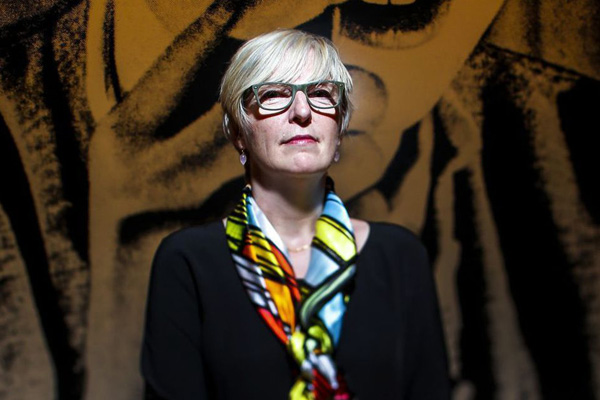
Philippe Vergne fires chief curator Helen Molesworth, shocking many in the art world. Molesworth had organized the popular and critically acclaimed exhibitions “Kerry James Marshall: Mastry” and a retrospective of Brazilian artist Anna Maria Maiolino. MOCA says the parting of ways is due to “creative differences.” But artist and board member Catherine Opie tells The Times that Molesworth had been fired for “undermining the museum.” When The Times asks whether the museum’s board of trustees stands by Vergne, MOCA does not respond.

A gala debacle goes public. MOCA had mailed May 12 “save the date” invitations for its 2018 gala honoring artist board member Mark Grotjahn. But Grotjahn declines to accept the award, citing a lack of diversity in the museum’s previous choices for gala honorees — all straight white men. The Grotjahn news comes around the same time that artist Lari Pittman, who is gay and Latino, resigns from the MOCA board, where he had held a seat since 2015. MOCA says it’s rethinking the gala and will formulate new gala plans, but it soon cancels the 2018 event altogether. The previous year’s gala raised more than $3 million, and the 2018 cancellation creates a fundraising gap.
MOCA names Helen Molesworth as chief curator. A scholar, art writer and curator, Molesworth had been at the Institute of Contemporary Art/Boston since 2010. Before that she headed the department of modern and contemporary art at the Harvard Art Museum. The museum announces that she will start Sept. 1.
The MOCA board approves Philippe Vergnes as MOCA’s next museum director. Born and educated in France, he’s a career museum professional who for more than five years has been director of the Dia Art Foundation, which operates a museum on the banks of the Hudson River in Beacon, N.Y., and owns famous land art installations in Utah and New Mexico. Vergnes is a career museum professional who previously had been senior curator at the Walker Art Center in Minneapolis, where he served more than 10 years. It’s the first time since 1980 that MOCA had hired a leader with hands-on experience running a museum. Jeremy Strick (hired in 1999) was an experienced curator but hadn’t held an executive post; Jeffrey Deitch (hired in 2010) had been a leading art dealer but arrived with scant museum experience.
MOCA announces that the campaign to raise its endowment to $100 million has met its goal in less than 10 months. The museum names 29 individuals, couples or foundations that have contributed, including 27 gifts from MOCA board members, or, in one case, a trustee’s parents. An unspecified number of anonymous gifts were also received. With pledges continuing to come in, the museum board lifts the goal to $150 million, setting no deadline for raising the additional $50 million. “There’s been this tremendous push by committed people who should commit and did commit,” says the MOCA board’s co-chair, Maria Bell. David Johnson, the other co-chair, says the museum now has “a sustainable financial future for the first time in its history.” Bell and Johnson served as co-chairs for more than five years, extending their final one-year term by 6 ½ months to help see the campaign through and provide stability during the as-yet unfinished search for a museum director to succeed Jeffrey Deitch. Because endowment principal is not supposed to be spent, with only the investment earnings to be funneled into operations, the impact on MOCA’s operating budgets will depend on how investment markets perform. An oft-used benchmark is to spend about 5% of an endowment fund’s value each year, hoping investment gains will be at least that large. Interim director Maria Seferian predicts that the endowment will yield more than a third of the museum’s annual operating funds, depending on market conditions.
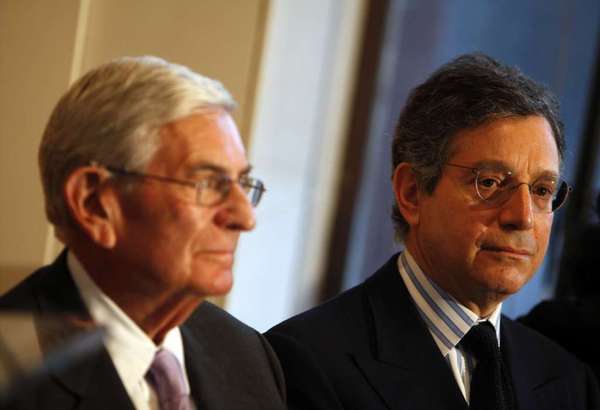
Jeffrey Deitch announced his resignation from his role as MOCA director at a meeting of the board of trustees Wednesday, July 24. MOCA’s board announced that it has formed a committee to search for Deitch’s replacement, and that Deitch “will stay on to ensure a smooth transition and the successful completion” of a campaign begun in March to boost MOCA’s endowment to $100 million. Deitch left his job Sept. 1, 2013.
Board chairs Maria Bell and David Johnson announce that its campaign to raise money for the museum’s endowment is three-quarters of the way toward the goal of $100 million. Fifty million dollars was pledged in the previous month alone; the money raised ensures that MOCA will collect the rest of the $15-million Eli Broad pledged in 2008 if it was matched by other donors. Johnson says Jeffrey Deitch remains MOCA’s director.
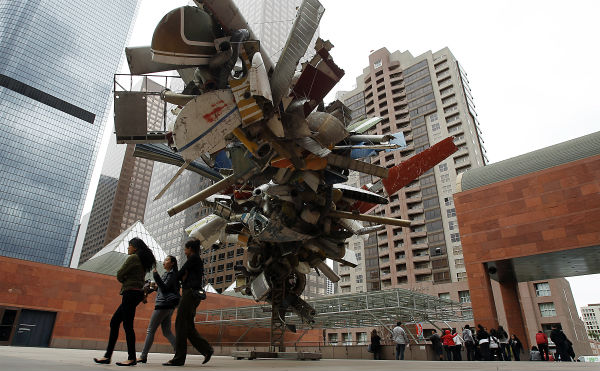
MOCA announces a fundraising campaign to build its endowment to $100 million and says board members’ commitments in the two previous weeks will bring it to more than $60 million. Two longtime trustees, board president Jeffrey Soros and Eugenio Lopez, are co-chairing the campaign, dubbed “MOCA Independence.”
MOCA’s board issues a statement saying it will keep MOCA independent and raise the money “to ensure its strong financial standing.” Board members reportedly quickly dismissed LACMA’s proposal, questioning LACMA’s long-term bond debt.

At the request of members of the MOCA board, Los Angeles County Museum of Art Director Michael Govan proposes that LACMA absorb MOCA while keeping the MOCA name and its two downtown buildings. LACMA would raise $100 million for it as part of the deal. The board chairman of the National Gallery of Art in Washington, D.C., says that it too has been in talks, instigated by Broad, with MOCA.
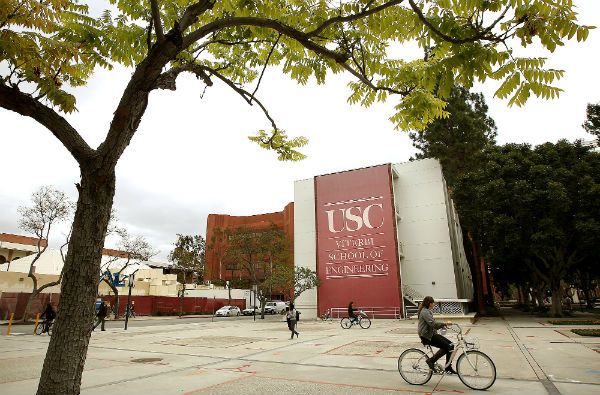
USC confirms that is in unspecified “partnership” talks with MOCA.
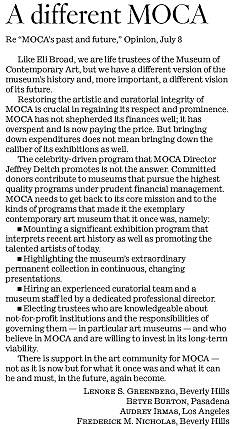
Broad’s July 8 column draws a response from four of his fellow MOCA life trustees, who say in a letter to The Times that “the celebrity-driven program that … Jeffrey Deitch promotes is not the answer,” and suggest MOCA needs to hire “a dedicated professional director.”

All four artists on the MOCA board — John Baldessari, Barbara Kruger, Catherine Opie and Ed Ruscha — resign.

Eli Broad writes an opinion article for the Los Angeles Times to reassure the public that MOCA is stable. Broad notes that MOCA’s new budget for 2012-13 is a prudent $14.3 million but does not say that it’s the museum’s lowest since the 1990s.
Responding to speculation, Broad denies in an interview that he has any intention of taking over MOCA’s prized collection for his own self-financed $130-million Broad Collection museum, due to open in 2014 across Grand Avenue from MOCA, with a promised endowment from Broad of at least $200 million.

Longtime chief curator Paul Schimmel, seen as an important part of MOCA’s strong reputation in the art world, is forced to resign after two years of frosty relations with Deitch.
Several board members resign or decline to renew when their terms expire. The chief financial officer and fundraising directors in place when Deitch began are gone, and their successors have left after less than a year on the job. MOCA’s financial condition comes into question when it delays a long-scheduled exhibition on Land Art so the Geffen Contemporary can be rented out to Mercedes-Benz for a free art, music and food festival.

Deitch has a popular triumph with “Art in the Streets,” a survey of the graffiti and street art movement that draws a record 201,352 viewers. But fundraising momentum fades during his first fiscal year at MOCA. Donations drop $4 million from the previous year.

Jeffrey Deitch begins work as museum director. Though he arrives with little museum experience, he has a big art world reputation as an adventurous New York City art dealer who helped build the collections of billionaires such as Broad. Fundraising for the 2009-10 fiscal year totals $18.6 million, and additions to the endowment since 2009 have drawn $6.25 million in matching funds from Broad.
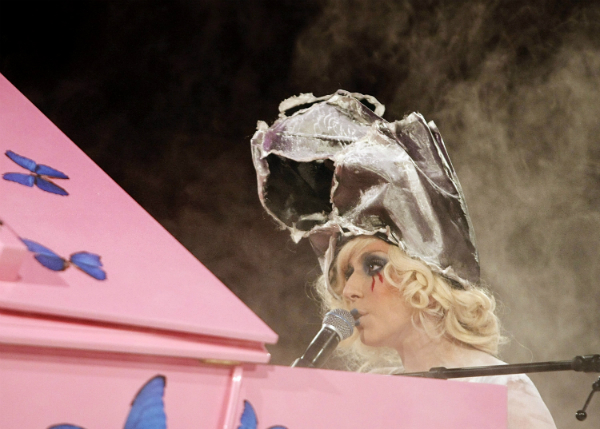
Young closes the Geffen Contemporary for most of 2009 and cuts staff, reducing annual expenses by a third. Declaring a “MOCA New” campaign, museum leaders announce fundraising progress, with donations reaching $29.5 million for the fiscal year, and recruit new trustees. A November gala featuring Lady Gaga marks the 30th anniversary of the museum’s founding and celebrates its return from the brink.
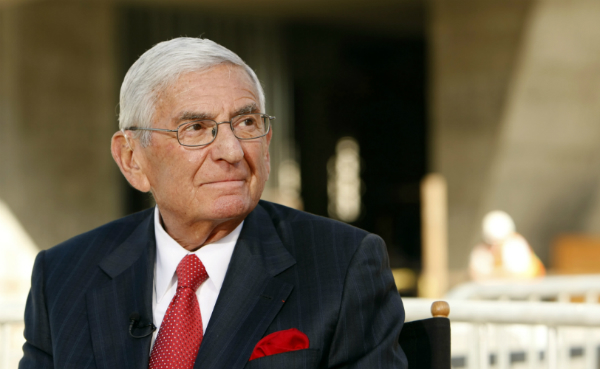
MOCA nearly collapses as its onetime $38.2-million endowment drops to $5 million in the global financial meltdown. The Los Angeles County Museum of Art offers to absorb MOCA, but Eli Broad pledges $15 million for exhibitions over five years and up to $15 million for the endowment if MOCA can raise matching funds. Former UCLA chancellor Charles Young is tapped as interim chief executive by Broad.
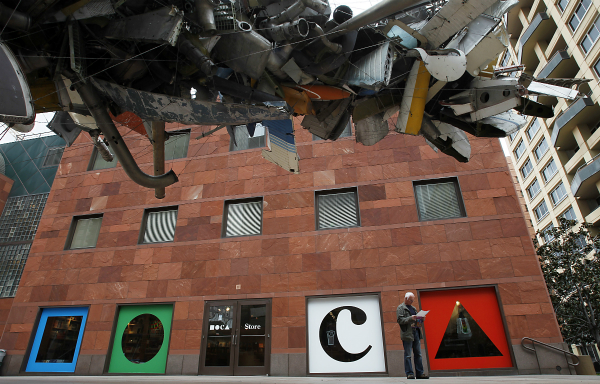
The Museum of Contemporary Art runs annual budget deficits averaging nearly $3 million; the museum draws on its endowment to pay operating costs. The California attorney general’s office later determines that the museum “did not meet the standard” in state law that restricts spending endowment principal.
Sources: Mike Boehm
